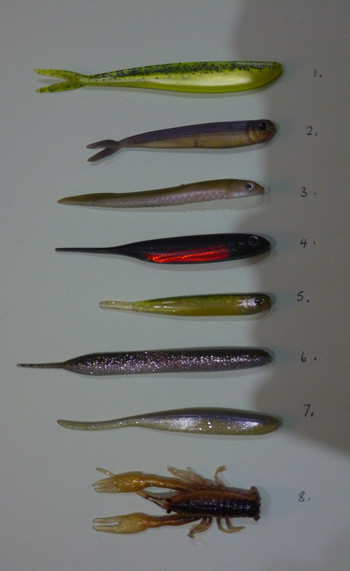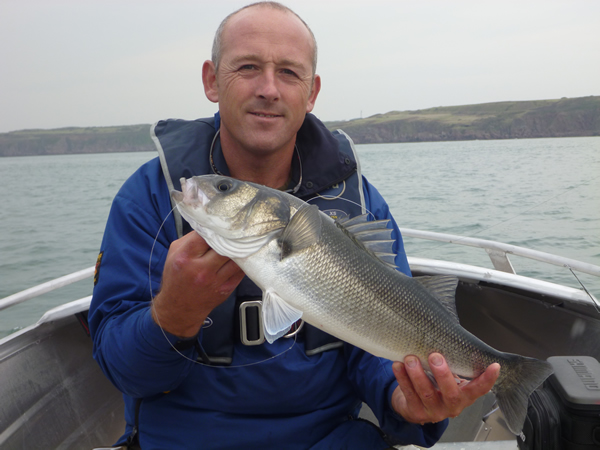The drop-shot method of fishing is a technique usually associated with freshwater predator anglers. It was through my off-season interest in perch fishing that I first chanced upon this method. My brother-in-law Simon Nicol, is a fanatical perch and zander angler and I owe a lot of my more recent technical lure fishing developments, and bits of this blog to him. It was on one of our winter forays that he introduced me to the drop-shot method. I initially dismissed this as just another, albeit interesting but fairly limited freshwater lure technique.
The drop-shot technique was developed in Japan for highly pressured largemouth bass. This has been whole heartedly adopted in the US and progressed even further. The array of tackle on offer, designed specifically for the technique, is mind boggling and, as in all things lure fishing, vastly over complicated.
The main species we are clearly aiming for are bass. However as I found out, this technique accounted for a number of other species, including pollack (very many!) wrasse, gurnard and even smoothhound! It also out fished some of the more conventional lure fishing methods in certain circumstances.
For those who have not come across this technique and are scratching their heads, I’d first better give a brief description of technically what it involves. You are effectively fishing a soft plastic lure (fish, worm or even craw) on a hook secured directly on your mainline, with a weight of some type below. The difference lies in the fact that there is no dropper or snood off the main line, the hook is attached with a specific knot directly off the line.
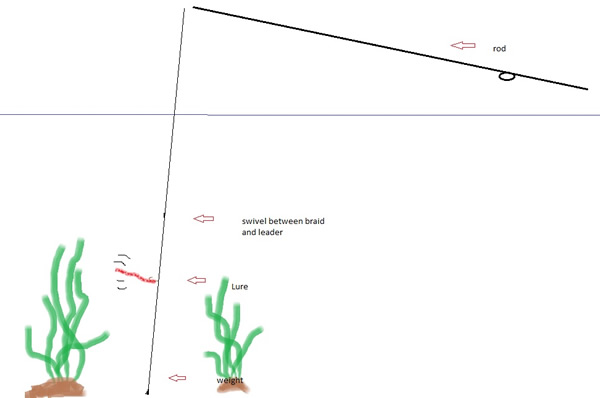
In terms of technique the main thing to bear in mind is that you are dangling highly enticing, natural looking bait that is twitching/undulating in a very realistic fashion whilst not moving out of any hot spot or likely looking area.
The basic approach is to find all those areas you would normally fish a lure through but do it slowly, methodically and very thoroughly: alongside submerged rocks, snags, weed beds, tight to harbour walls, ledges or moored boats. All the usual places, in fact, that you’d throw a lure at and then pull it away from. That’s the beauty of this method. You’re not splashing a lure down, into a quiet spot, twenty times to fish the water mid-way between where you want to and where you’re standing (wondering all the time if your depth is right?) You’re actually throwing a lure once and doing you’re best to keep a life-like bait right bang in front of a fish of exactly the depth you intended to be – for as long as you choose to.
If you search the vast amount of information from the U.S. on drop-shotting, you’ll glean one main piece of advice and that is the following “Cast out, allow the bait to settle, tighten up begin shaking the rod for about a minute. If nothing happens, turn the reel handle ten times and begin shaking the rod tip again. Rinse and repeat….”
It certainly pays to have a practice go, in an area of gin clear water with reasonable depth just below you. Just observe the lure and resultant action from shaking / twitching the rod. Using braid it is interesting to see just how much of a natural action you can generate from very limited rod action.
Fishing the drop-shot can be, very possibly, the simplest of all techniques to achieve success with. As with all fishing techniques, there are a myriad of subtleties, tricks and adaptations which are far too many to describe here, but will come naturally to any half-competent angler once they try this.
Tackle
There are technique specific rods available for drop-shotting, however most are aimed at the freshwater market and probably somewhat light for saltwater work unless it was LRF? I’ve found for boat work a short rod that is quite stiff, yet still with a light tip best suits me. I use a Sakura Rookie 7.5ft 10-35g rating. For the shore I find a slightly longer rod helps with keeping a better angle for working the lure. Most modern lure rods are stiff but light enough to suit this type of fishing.
Conventional lure fixed spool reels are ideal. Line of choice is braid with a fluoro leader. This can be attached with any of the standard braid to fluoro knots like an Albright or with a small swivel. Hooks can be attached with a few specific knots, the best known of which is the Palomar.
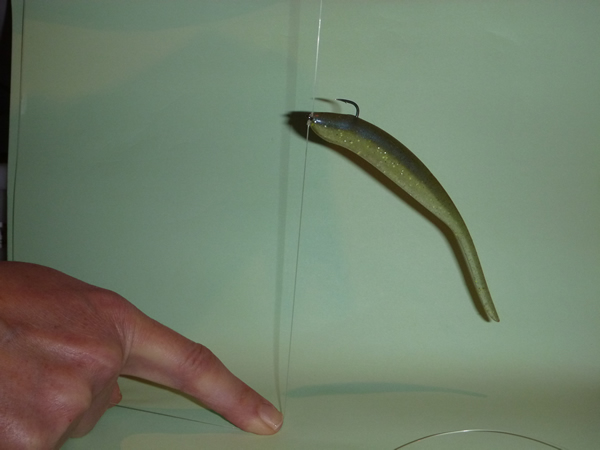 Hook choice depends on the lures used but can be purpose bought drop-shot hooks or other improvised single hooks of a size to usually nose hook whatever soft plastic you choose. You can drop-shot using weedless worm hooks if the ground is particularly rough. You can also buy specific drop-shot hooks which are mounted on a short piece of eyed wire, which negates the need for specific knots.
Hook choice depends on the lures used but can be purpose bought drop-shot hooks or other improvised single hooks of a size to usually nose hook whatever soft plastic you choose. You can drop-shot using weedless worm hooks if the ground is particularly rough. You can also buy specific drop-shot hooks which are mounted on a short piece of eyed wire, which negates the need for specific knots.
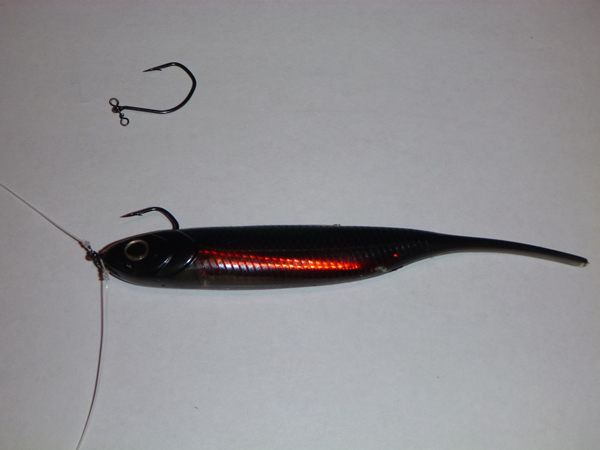
Lures
There are fundamentally 2 types of lure that are applicable to bass drop shotting: soft plastic worm type and soft plastic fish type. There are potentially soft plastic creature type baits like craws for species like wrasse but I will concentrate on bass.
There are no real limits to what size you can fish but if you start to use really large lures say 9” or so, you start to have issues with attaching stinger hooks, otherwise you’ll start missing takes.
Whatever you choose, consider how it will look in the water? In my opinion you are probably better going for pintails and forktails rather than paddletails and lures that require a forward motion to ‘work’. They can catch in lots of tide but it’s more a bait that quivers, ripples and shudders that proves deadly.
- Lunker City Fin-S-Fish
- Fishbelly Hawg Shad
- Hogey slug
- Fish Arrow ‘Flash J’
- Illex Super Pintail
- Keitech Sexy Impact
- Keitech Live impact
- Storm ‘Craw’
Surprisingly it has been from the boat that I see this technique most valuable. This I think is down to the fact that this technique opens up a whole area of fishing – namely deep, tidal water that is hard to fish with some of the conventional lure techniques. Also because you can set the lure at any chosen depth above your weight you can fish effectively weedless. You can fish into kelp beds with the lure set at a height just above the weed fronds – free from snagging but close enough to the weed to imitate any small baitfish you are likely to find there. You may have to sacrifice weights using a type of ‘rotten bottom’ end rig but hey, weights are pretty cheap and can be mass produced at home.
When fishing from the boat and drifting in the tide, simply hold the rod and let the boats movement over the ground do the work. This method surprisingly results in less snags than dropping say a weighted paddletail or Black Minnow. You can also fish more than one lure on the line to cover more depth. I guess you could fish multiple lures but it would start to resemble feathering?
I think it is the 2 facts – 1. Fishing with a lure tight to the line and 2. Using a weight underneath, that may put some of the purist lure anglers off? However the lure on the line issue is just a different concept, and once used to it, no more alien than fishing a weedless lure was say 10 years ago? The weight below does represent a change for most lure anglers, however I use as little as can be got away with – 10g or even less in some instances. For serious depths and tide races then you would need to step up to much heavier weights. But these spots would not be fishable using conventional lure tactics anyway?
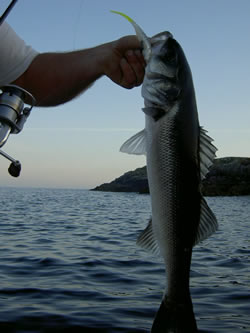 Drop-shotting from the shore is something I have less experience, however there must be situations where this technique would work well? It should be remembered that keeping the angle under about 50-60 degrees (assuming straight down is 0 degrees) is important. You’re aiming for a lure that sits quivering on the horizontal and too shallow an angle of line, will cause the bait to sit nose down, not really a natural presentation for 18 inches off the bottom. This means that fishing at long distance is not really going to present the lure effectively, especially in shallow water.
Drop-shotting from the shore is something I have less experience, however there must be situations where this technique would work well? It should be remembered that keeping the angle under about 50-60 degrees (assuming straight down is 0 degrees) is important. You’re aiming for a lure that sits quivering on the horizontal and too shallow an angle of line, will cause the bait to sit nose down, not really a natural presentation for 18 inches off the bottom. This means that fishing at long distance is not really going to present the lure effectively, especially in shallow water.
However if you have locations where fish are feeding close to shore with a reasonable depth, for example around specific features, there must be advantages of holding your lure twitching enticingly close to this feature. Examples that spring to mind would be large rocks, groynes or jetties and perhaps sand holes in kelp? Also down the sides of piers and stations?
Like any different or new technique, it’s all about experimenting and perseverance. When results come, this brings the all important confidence in the technique. I’m as guilty as any in terms of sticking to tried and tested techniques, but remember did you always use those now tried and tested techniques when you started out? No one is suggesting this technique will take over from more conventional methods but in times of decreasing numbers of fish, it’s maybe good to have another string to your bow?
Author: Gareth Henson
